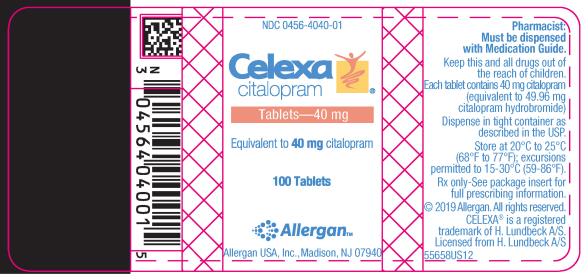Celexa
Generic name: citalopram
Drug class: Selective serotonin reuptake inhibitors
Medically reviewed by A Ras MD.
What is Celexa?
Celexa is a prescription medicine used to treat depression. It is important to talk with your healthcare provider about the risks of treating depression and also the risks of not treating it. You should discuss all treatment choices with your healthcare provider. Celexa is also used to treat Major Depressive Disorder (MDD), Talk to your healthcare provider if you do not think that your condition is getting better with Celexa treatment.
Description
Celexa contains citalopram, a selective serotonin reuptake inhibitor (SSRI). Citalopram hydrobromide is a racemic bicyclic phthalane structure and is designated (±)-1-(3-dimethylaminopropyl)-1-(4-fluorophenyl)-1,3-dihydroisobenzofuran-5-carbonitrile hydrobromide with the following structural formula:

The molecular formula is C20H22BrFN2O and its molecular weight is 405.35.
Citalopram hydrobromide occurs as a fine, white to off-white powder. Citalopram hydrobromide is sparingly soluble in water and soluble in ethanol.
CELEXA tablets are for oral administration and are available as film-coated oval tablets. The strengths reflect citalopram base equivalent content. The 10 mg, 20 mg, and 40 mg strength tablets contain 12.49 mg, 24.98 mg, and 49.96 mg of citalopram hydrobromide, respectively. The 20 mg and 40 mg tablets are scored.
Inactive ingredients: copolyvidone, corn starch, crosscarmellose sodium, glycerin, lactose monohydrate, magnesium stearate, hypromellose, microcrystalline cellulose, polyethylene glycol, and titanium dioxide. Iron oxides are used as coloring agents in the beige (10 mg) and pink (20 mg) tablets.
Mechanism of Action
The mechanism of action of citalopram is unclear, but is presumed to be related to potentiation of serotonergic activity in the central nervous system (CNS) resulting from its inhibition of CNS neuronal reuptake of serotonin (5-HT).
What is the most important information I should know about Celexa?
Celexa and other antidepressant medicines may cause serious side effects, including:
1. Suicidal thoughts or actions:
- Celexa and other antidepressant medicines may increase suicidal thoughts or actions in some children, teenagers, or young adults within the first few months of treatment or when the dose is changed.
- Depression or other serious mental illnesses are the most important causes of suicidal thoughts or actions.
- Watch for these changes and call your healthcare provider right away if you notice:
- New or sudden changes in mood, behavior, actions, thoughts, or feelings, especially if severe.
- Pay particular attention to such changes when Celexa is started or when the dose is changed.
Keep all follow-up visits with your healthcare provider and call between visits if you are worried about symptoms.
Call your healthcare provider right away if you have any of the following symptoms, or call 911 if an emergency, especially if they are new, worse, or worry you:
- attempts to commit suicide
- acting on dangerous impulses
- acting aggressive or violent
- thoughts about suicide or dying
- new or worse depression
- new or worse anxiety or panic attacks
- feeling agitated, restless, angry or irritable
- trouble sleeping
- an increase in activity or talking more than what is normal for you
- other unusual changes in behavior or mood
2. Changes in the electrical activity of your heart (QT prolongation and Torsade de Pointes).
This condition can be life threatening.
The symptoms may include:
- Chest pain
- fast or slow heartbeat
- shortness of breath
- dizziness or fainting
3. Serotonin syndrome.
This condition can be life-threatening and may include:
- agitation, hallucinations, coma or other changes in mental status
- coordination problems or muscle twitching (overactive reflexes)
- racing heartbeat, high or low blood pressure
- sweating or fever
- nausea, vomiting, or diarrhea and muscle rigidity
4. Severe allergic reactions.
- trouble breathing, swelling of the face, tongue, eyes or mouth
- rash, itchy welts (hives) or blisters, alone or with fever or joint pain
5. Abnormal bleeding.
Celexa and other antidepressant medicines may increase your risk of bleeding or bruising, especially if you take the blood thinner warfarin (Coumadin, Jantoven), a non-steroidal antiinflammatory drug (NSAIDs, like ibuprofen or naproxen), or aspirin.
6. Seizures or convulsions.
7. Manic episodes.
- greatly increased energy
- severe trouble sleeping
- racing thoughts, reckless behavior
- unusually grand ideas
- excessive happiness or irritability, talking more or faster than usual
8. Changes in appetite or weight.
Children and adolescents should have height and weight monitored during treatment.
9. Low salt (sodium) levels in the blood.
Elderly people may be at greater risk for this. Symptoms may include:
- headache
- weakness or feeling unsteady
- confusion, problems concentrating or thinking or memory problems
10. Visual problems.
- eye pain
- changes in vision
- swelling or redness in or around the eye
Only some people are at risk for these problems. You may want to undergo an eye examination to see if you are at risk and receive preventative treatment if you are.
Do not stop Celexa without first talking to your healthcare provider.
Stopping Celexa too quickly may cause serious symptoms including:
- anxiety, irritability, high or low mood, feeling restless or changes in sleep habits
- headache, sweating, nausea, dizziness
- electric shock-like sensations, shaking, confusion
Who should not take Celexa?
Do not take Celexa if you:
- are allergic to citalopram or escitalopram or any of the ingredients in Celexa. See the end of this Medication Guide for a complete list of ingredients in Celexa.
- take a monoamine oxidase inhibitor (MAOI). Ask your healthcare provider or pharmacist if you are not sure if you take an MAOI, including the antibiotic linezolid.
- Do not take an MAOI within 2 weeks of stopping Celexa unless directed to do so by your physician.
- Do not start Celexa if you stopped taking an MAOI in the last 2 weeks unless directed to do so by your physician.
People who take Celexa close in time to an MAOI may have serious or even life-threatening side effects. Get medical help right away if you have any of these symptoms:
- high fever
- uncontrolled muscle spasms
- stiff muscles
- rapid changes in heart rate or blood pressure
- confusion
- loss of consciousness (pass out)
- have a heart problem including congenital long QT syndrome
- Do not take Celexa with Orap (pimozide) because taking these two drugs together can cause serious heart problems.
What should I tell my healthcare provider before taking Celexa?
Before starting Celexa, tell your healthcare provider if you are taking certain drugs such as:
- Medicines for heart problems
- Medicines that lower your potassium or magnesium levels in your body
- Cimetidine
- Triptans used to treat migraine headache
- Medicines used to treat mood, anxiety, psychotic or thought disorders, including tricyclics, lithium, SSRIs, SNRIs, amphetamines, or antipsychotics
- Tramadol
- Over-the-counter supplements such as tryptophan or St. John’s Wort
Before starting Celexa, tell your healthcare provider if you:
- have liver problems
- have kidney problems
- have heart problems
- have or had seizures or convulsions
- have bipolar disorder or mania
- have low sodium levels in your blood
- have a history of a stroke
- have high blood pressure
- have or had bleeding problems
- are pregnant or plan to become pregnant. It is not known if Celexa will harm your unborn baby. Talk to your healthcare provider about the benefits and risks of treating depression during pregnancy
- are breast-feeding or plan to breastfeed. Some Celexa may pass into your breast milk. Talk to your healthcare provider about the best way to feed your baby while taking Celexa.
Tell your healthcare provider about all the medicines that you take, including prescription and non-prescription medicines, vitamins, and herbal supplements. Celexa and some medicines may interact with each other, may not work as well, or may cause serious side effects.
Your healthcare provider or pharmacist can tell you if it is safe to take Celexa with your other medicines. Do not start or stop any medicine while taking Celexa without talking to your healthcare provider first.
Ask if you are not sure.
If you take Celexa, you should not take any other medicines that contain citalopram or escitalopram including: Lexapro.
How should I take Celexa?
- Take Celexa exactly as prescribed. Your healthcare provider may need to change the dose of Celexa until it is the right dose for you.
- Celexa may be taken with or without food.
- If you miss a dose of Celexa, take the missed dose as soon as you remember. If it is almost time for the next dose, skip the missed dose and take your next dose at the regular time. Do not take two doses of Celexa at the same time.
- If you take too much Celexa, call your healthcare provider or poison control center right away, or get emergency treatment.
What should I avoid while taking Celexa?
Celexa can cause sleepiness or may affect your ability to make decisions, think clearly, or react quickly. You should not drive, operate heavy machinery, or do other dangerous activities until you know how Celexa affects you. Do not drink alcohol while using Celexa.
What are the possible side effects of Celexa?
Celexa may cause serious side effects, including:
- See “What is the most important information I should know about Celexa?” above.
Common possible side effects in people who take Celexa include:
- Nausea
- Sleepiness
- Weakness
- Dizziness
- Feeling anxious
- Trouble sleeping
- Sexual problems
- Sweating
- Shaking
- Not feeling hungry
- Dry mouth
- Constipation
- Diarrhea
- Respiratory Infections
- Yawning
Other side effects in children and adolescents include:
- increased thirst
- abnormal increase in muscle movement or agitation
- nose bleed
- urinating more often
- heavy menstrual periods
- possible slowed growth rate and weight change. Your child’s height and weight should be monitored during treatment with Celexa.
Tell your healthcare provider if you have any side effect that bothers you or that does not go away. These are not all the possible side effects of Celexa. For more information, ask your healthcare provider or pharmacist.
Call your doctor for medical advice about side effects. you may report side effects to the FDA at 1800-FDA-1088.
General information about Celexa
Medicines are sometimes prescribed for purposes other than those listed in a Medication Guide. Do not use Celexa for a condition for which it was not prescribed. Do not give Celexa to other people, even if they have the same condition. It may harm them.
This Medication Guide summarizes the most important information about Celexa. If you would like more information, talk with your healthcare provider. You may ask your healthcare provider or pharmacist for information about Celexa that is written for healthcare professionals.
For more information about Celexa call 1-800-678-1605.
How should I store Celexa?
- Store Celexa at 25°C (77°F), between 15°C to 30°C (59°F to 86°F).
- Keep Celexa bottle closed tightly.
Keep Celexa and all medicines out of the reach of children.
What are the ingredients in Celexa?
Active ingredient: citalopram hydrobromide
Inactive ingredients: copolyvidone, corn starch, crosscarmellose sodium, glycerin, lactose monohydrate, magnesium stearate, hypromellose, microcrystalline cellulose, polyethylene glycol, titanium dioxide and iron dioxide for coloring.
Label
-
- PRINCIPAL DISPLAY PANEL
NDC 0456-4010-01
Celexa
citalopram
Tablets – 10 mg
100 Tablets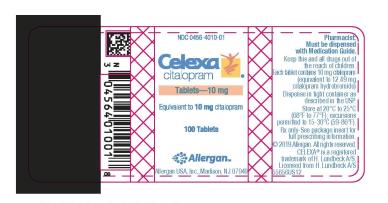
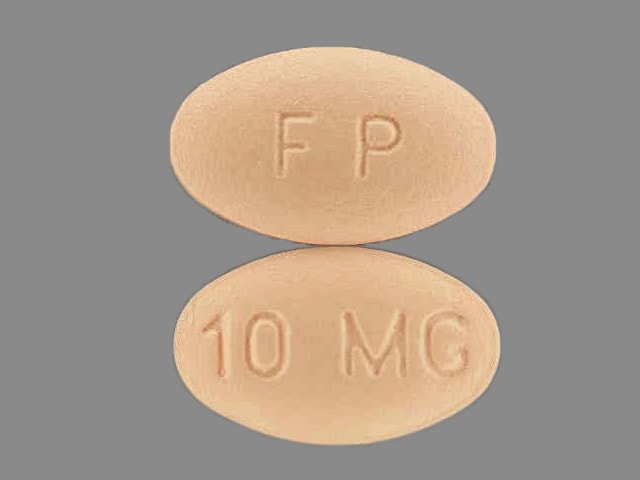
- PRINCIPAL DISPLAY PANEL
PRINCIPAL DISPLAY PANEL
NDC 0456-4020-01
Celexa
citalopram
Tablets – 20 mg
100 Tablets
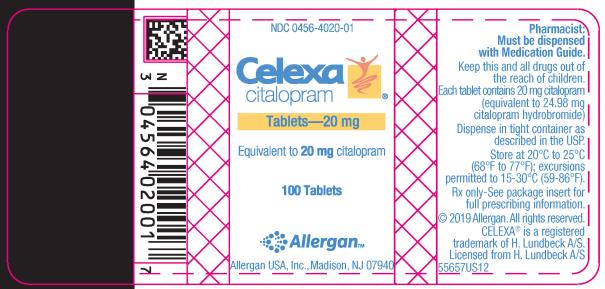
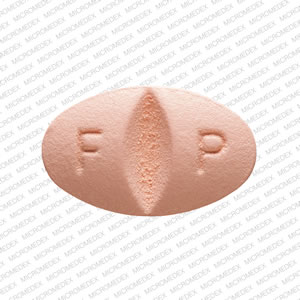
PRINCIPAL DISPLAY PANEL

